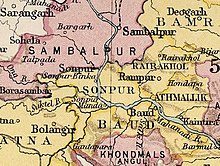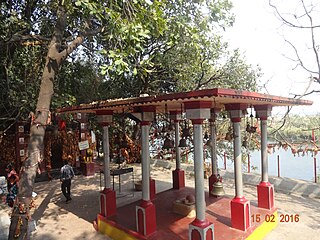
Sambalpur District is a district in the western part of state of Odisha, India. The historic city of Sambalpur is the district headquarters.
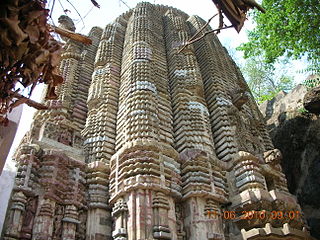
Bargarh District is an administrative district of Odisha state in eastern India. The city of Bargarh is its district headquarters. The district was carved out of the erstwhile district of Sambalpur on 1 April 1993.
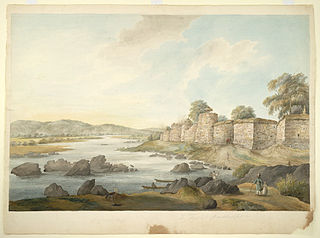
Sambalpur is the fifth largest city in the Indian State of Odisha. It is located on the banks of river Mahanadi, with a population of 335,761. Prehistoric settlements have been recorded there. It is the home of the Sambalpuri sari.

Dhenkanal State was one of the princely states of India during the period of the British Raj. The state is now referred to as Dhenkanal district, Odisha, with Dhenkanal town as its district headquarters.

The history of Odisha begins in the Lower Paleolithic era, as Acheulian tools dating to the period have been discovered in various places in the region. The early history of Odisha can be traced back to writings found in ancient texts like the Mahabharata, Maha Govinda Sutta and some Puranas. The region was also known to other kingdoms in region of East Indies due to maritime trade relations.

Veer Surendra Sai was a native Indian as well as a regional freedom fighter from Odisha. He fought against the British rule in India after they dethroned the king and queen of Sambalpur State as he was the legal heir. Veer Surendra Sai and his associates Madho Singh, Kunjal Singh, Airi Singh, Bairi Singh, Uddant Sai, Ujjal Sai, Khageswar Dao, Karunakar Singh, Salegram Bariha, Govind Singh, Pahar Singh, Rajee Ghasia, Kamal Singh, Hati Singh, Salik Ram Bariha, Loknath Panda/Gadtia, Mrutunjaya Panigrahi, Jagabandu Hota, Padmanabha Guru, Trilochan Panigrahi, and many others worked together and separately to counter British colonial expansion in India, preventing the British authorities from assuming control over the majority of Western Odisha region for a significant period of time. Many of them were tried and executed by the colonial authorities; Hatte Singh died at the Kalapani Jail in the Andamans. Lion of Sambalpur Veer Surendra Sai died in Asirgarh Jail on 28 February 1884.
Western Odisha is the western part of the state of Odisha in India, extending from the Kalahandi district in the south to the Sundargarh district in the north.

Patna State was a princely state in the Eastern States Agency of India during the British Raj. It had its capital at Balangir. Its area was 6,503 km2 (2,511 sq mi).

Sambalpur is a district of Odisha. Sambalpur city is the headquarter of Sambalpur district. Sambalpur is the cultural capital of Western Odisha.
Sonepur, is the district headquarters of Subarnapur district of Odisha, has a special place on the political and cultural map of India since the pre-historic period. It is bounded on the north by Sambalpur district, on the south and the South-East by Boudh district, on the east by Rairakhol sub-division of Sambalpur district and on the west by the ex-state Patna.

Sonepur, also known as Sonpur State, was one of the princely states of India during the period of the British Raj. Its ruler was entitled to a nine gun salute. Formerly it was placed under the Central India Agency, but in 1905 it was transferred to the Eastern States Agency. Its capital was Sonepur, the only significant town in the area. The former state's territory is in the present-day Subarnapur district, Odisha.

Sarangarh was a princely state in India during the British Raj ruled by a Raj Gond dynasty. The emblem of the state was a turtle.
Ramai Deva or Ramai Deo was a Rajput ruler who founded the Chauhan Dynasty rule in the erstwhile Patna state in today’s Bolangir district of Odisha in the year 1360 A.D. At the young age of twenty he staged a coup with the popular support of the commoners and overtook the Astha Mullicks or the eight regional Gauntias ruling as independent warlords in oligarchy after the Eastern Ganga administrator of the region died. The central control of the Gangas had nearly collapsed due to outside invasions. As an energetic and remarkable leader, he established his firm control of the erstwhile Patna state Odisha that might have included some parts of Chatishgarh as well.
Balarama Deva or Balaram Deo was the first Chauhan ruler of Sambalpur State and the tenth in line ruler of the Chauhan dynasty in the Western Odisha region during the sixteenth century. He was a powerful ruler and an excellent military strategist who ruled the hilly and forest tracts of western Odisha that was mostly inhabited by different tribal or aboriginal communities. After his ascension to the throne in the year 1570 CE, he secured the region from the neighboring Ratanpur's Haihayas and build a strong state surpassing the glory of his ancestral Chauhan state of Patna (Bolangir). Balarama Deva had also provided military assistance to the Gajapati king Ramachandra Deva of Khurda Kingdom and help to defend Khurda kingdom from the invading Muslim armies who either belonged to the Mughal Dynasty or the Golconda Sultanate. After consolidation of his authority over the regions of western Odisha and now parts of the state of Chattishgarh, Balarama Deva himself installed the idol of Goddess Samleswari as the head family deity which began the era of cultural rejuvenation in the region.
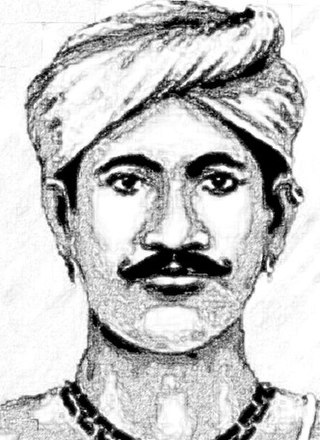
Madhab Singh Bariha or Madho Singh was the Binjhal Zamindar (landlord) of Ghess locality of Bargarh district in Odisha and was a close associate of Veer Surendra Sai in the Sambalpur uprising against the British East India Company. He was hanged to death at the age of 72 on 31 December 1858 at Jail Chowk of Sambalpur, after being caught in the same year for his ferocious and heroic resistance to the British takeover of the region with their appalling policies. Three out of his four valiant sons were martyred while the eldest was sentenced to life imprisonment. His granddaughter Purnima committed suicide after the British hanged her rebellious husband from the Sonakhan Zamindari at Raipur.

Karunkar Singh Naik, commonly known as Karunakar Singh, was an Indian chieftain and rebel leader. He was the Gond Zamindar of Kolabira in what is today the Jharsuguda district of Odisha.
Kamal Singh Dao or only known as Kamal Singh was the son of Balabhadra Singh Dao, the Gond Zamindar (landlord) of Lakhanpur locality of Bargarh district of Odisha and was a major aide of Veer Surendra Sai during the Sambalpur uprising against the British. He along with his brothers Khageswar Singh and Neelambar Singh played an important role as one of the second in commands of Surendra Sai. Kamal's father Balabhadra Singh attained martyrdom in the earlier days of the rebellion. Kamal was treacherously killed in sleep while resting under a tree and when he was still in command of the rebels even though Surendra Sai himself had surrendered to the British. His brother Khageswar died under British imprisonment in Asirgarh jail.

The Bhoi dynasty or the Yaduvamsa dynasty were a medieval Hindu dynasty from the Indian subcontinent, which originated in the region of Odisha that reigned from 1541 to 1560 CE. Govinda Vidyadhara had usurped the throne from the later weaker Suryavamsa Gajapati Empire rulers as the kingdom started weakening but had a short-lived reign as ruling chiefs of Odisha as the ensuing internal rivalries and constant threats of invasions rendered them weak and were eventually overthrown by Mukunda Deva of Chalukya dynasty in 1560.
Emperor Firoz Shah Tughlaq launched a military expedition against the Chauhans of Sambalpur, a Rajput kingdom in Odisha ruled by the Somvanshi Rajputs. The purpose of this expedition was to break the power of the Odia kings and bring the region under the control of the Delhi Sultanate. Visaldeva was the last ruler of the Chauhan Kingdom of Sambalpur during this time.
